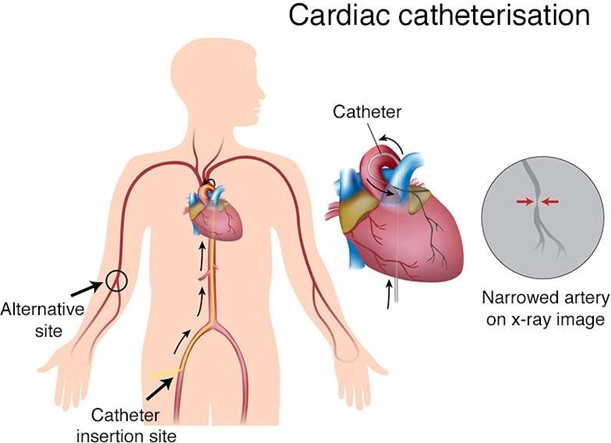A nurse is providing teaching to a 10-year-old child who is scheduled for an arterial cardiac catheterization.
Which of the following information should the nurse include in the teaching?
"You will need to keep your leg straight for 8 hours following the procedure.”
"You will have your dressing removed 12 hours after the procedure.”
"You will be on a clear liquid diet for 24 hours following the procedure.”
"You will be on bed rest for 2 days after the procedure.”
The Correct Answer is A
After an arterial cardiac catheterization, the patient will need to keep their leg straight for several hours following the procedure to prevent bleeding from the catheter insertion site.

Choice B is wrong because droplet isolation precautions are not necessary after an arterial cardiac catheterization.
Choice C is wrong because assisting the child into a supine position may not be necessary and could be uncomfortable for the child.
Choice D is wrong because checking oxygen saturation every 4 hours may not be frequent enough for a child who has undergone an arterial cardiaccatheterization and may require more frequent monitoring of oxygen saturation.
Nursing Test Bank
Naxlex Comprehensive Predictor Exams
Related Questions
Correct Answer is D
Explanation
The nurse should prepare the toddler for nasotracheal intubation first because the toddler is experiencing severe dyspnea and drooling, which are signs of airway obstruction.
Nasotracheal intubation will help to secure the toddler’s airway and improve their breathing.
Choice A is wrong because administering an antibiotic is not the priority intervention for a toddler with airway obstruction.
Choice B is wrong because obtaining a blood culture is not the priority intervention for a toddler with airway obstruction.
Choice C is wrong because inserting an IV catheter is not the priority intervention for a toddler with airway obstruction.
Correct Answer is C
Explanation
According to UCSF Benioff Children’s Hospital Oakland Orthopaedic Department, you can change your baby’s diaper with the Pavlik harness in place and make sure the straps are kept outside of the diaper.
Choice A is wrong because while your child is being treated in the Pavlik harness, it is very important that you do not remove the harness or adjust the straps, unless you are given specific instructions by your doctor to do so.
Choice B is wrong because there are no instructions to apply lotion to the skin under the straps.
Choice D is wrong because the duration of treatment will be determined by your doctor and may vary.
Whether you are a student looking to ace your exams or a practicing nurse seeking to enhance your expertise , our nursing education contents will empower you with the confidence and competence to make a difference in the lives of patients and become a respected leader in the healthcare field.
Visit Naxlex, invest in your future and unlock endless possibilities with our unparalleled nursing education contents today
Report Wrong Answer on the Current Question
Do you disagree with the answer? If yes, what is your expected answer? Explain.
Kindly be descriptive with the issue you are facing.
